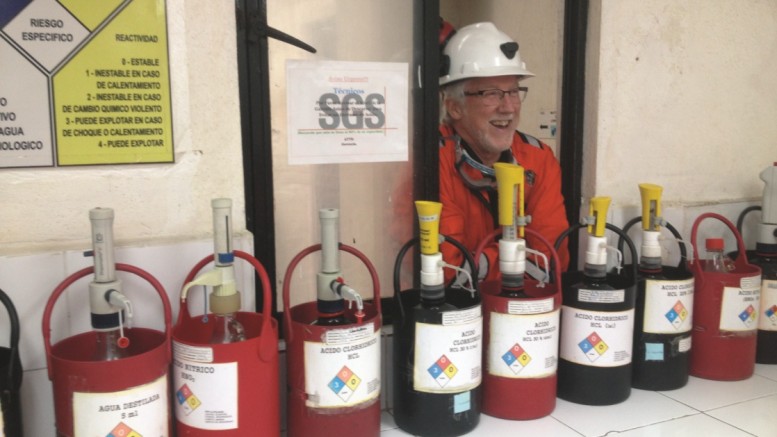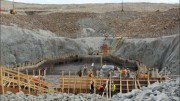It’s easy for your mind to drift back into history when visiting Great Panther Silver’s (TSX: GPR; NYSE-MKT: GPL) silver-gold operations at its Guanajuato mine complex (GMC) in the city of Guanajuato, Mexico, a UNESCO World Heritage Site.
The narrow road that leads to the underground operation winds between colourful Spanish baroque-inspired architecture, with local musicians, dressed in traditional seventeenth century costumes, at almost every turn.
Beneath the vibrant city, however, is a different scene. Since 1548, miners have carved a labyrinth of tunnels that extend 4.2 km long and up to 1 km deep, largely engineered by Spanish colonists chasing the district’s rich epithermal silver veins.
Over its 400-year mining history, more than 1 billion oz. silver and 4 million oz. gold have been mined from the GMC, making it the second-largest silver district in Mexico, behind Fresnillo in Zacatecas state.
Great Panther showed up in town in 2005 to buy the GMC and San Ignacio claims, and its associated mining infrastructure, for US$7.3 million from the “Sociedad Cooperativa Minera Metalurgica Santa Fe de Guanajuato,” otherwise known as the Cooperative.
As we arrived at Great Panther’s milling and office buildings, The Northern Miner was joined by president and CEO Robert Archer, who described his first experience of Guanajuato and its operations over a decade ago.
“The miners were chiselling the veins by hand on their backs, and there was very little drilling completed on the property,” he said. “The silver price was US$7 per ounce and change and the Cooperative was losing money on a daily basis. So we saw it as an opportunity to build resources and create a more modern and longer-life operation.”
Shortly after acquiring the property, Great Panther began underground mining five main veins across the GMC: Guanajuatito, Cata Clavo, Los Pozos, Santa Margarita and San Cayetano.
The ore is moved to the firm’s 1,200-tonne-per-day milling facility via underground tunnels at a rate of 400 tonnes per day.

Great Panther Silver’s 1,200 tonnes per day mill at its GMC silver-gold mine in Guanajuato, Mexico. Photo by Lesley Stokes.
In 2014, the company added material from its San Ignacio mine, located 22 km from the mill. Archer says the company plans to ramp up production at San Ignacio from its current 550 tonnes per day to 700 tonnes per day by year-end.
San Ignacio is next to Endeavour Silver’s (TSX: EDR; NYSE: EXK) Lucero mine, a now-depleted satellite deposit to the company’s larger Bolanitos operation, 2 km north, which produced 277,000 oz. silver and 8,500 oz. gold during this year’s second quarter.
“San Ignacio really helped us through the downturn, especially last year. When we started production, the veins were 2 or 3 metres wide, but they ballooned out to 15 metres and the grades increased once we did step-out drilling,” he said. “That allowed us to change the mine plan, and we increased tonnage and ounces when it was critical to keep costs down and production up.”
A drive into San Ignacio’s tunnels with Great Panther’s vice-president of exploration, Robert Brown, offers a different kind of history lesson.
The dark, volcanic walls are cut with brilliant white and banded quartz-carbonate veins that are the remnants of the hydrothermal fluids that filled the cracks.

A cut of a mineralized epithermal vein at Great Panther Silver’s San Ignacio underground silver-gold operations. Photo by Lesley Stokes.
Brown says that the degree of silver and gold mineralization largely depends on where the fluids reached boiling temperatures within the crust.
“San Ignacio was a one-phase system, it cracked and then the fluids came in. The elevations where boiling occurred is quite consistent around 2,340 metres elevation for 150 metres vertical extent,” he says, “whereas mineralization at Guanajuato occurred over and over again in several pulses, and fluctuated over larger vertical extents. Perhaps it might’ve been the core of the system, or closest to the heat source.”
While underground, Archer said the company has budgeted 16,000 metres of drilling at the GMC and San Ignacio this year. The goal, he says, is to “increase our regional and local resource base to the point where we can justify a plant expansion.
“At this point we can’t say whether or not we’ll do it, it depends on the success of the drilling programs. But to justify it you need a resource base first,” he said. “Guanajuato is a world-class deposit and a long-life operation, and there’s still a lot of potential to keep the mine going. We’re always finding new mineralization zones.”

Mineralized epithermal vein in drill core from Great Panther Silver’s GMC operation. Photo by Lesley Stokes.
The company also has access to old mining stopes at the GMC, which could add between 200,000 and 290,000 tonnes ranging from 59 to 252 grams silver per tonne and 1.03 to 3.52 grams gold per tonne.
Existing measured and indicated resources at the GMC, as of July last year, add up to 150,000 tonnes of 269 grams silver and 1.5 grams gold, for a total of 1.81 million equivalent oz. silver.
Inferred resources tack on 136,000 tonnes of 151 grams silver and 2.3 grams gold for 1.36 million equivalent oz. silver. Both calculations assume a US$74 net smelter return (NSR) cut-off and US$15 per oz. silver and US$1,100 per oz. gold.
“We’ll never have a large resource base here, that’s just way it is. Our goal is to replace what we mine each year and always stay a little bit ahead,” Archer said.
He adds that 30% of what Great Panther mines is outside the resource area, because the mineralization occurs too close to historical workings and can’t be block-modelled to National Instrument 43-101 reporting standards.
Last December, measured and indicated resources at San Ignacio stood at 360,000 tonnes of 145 grams silver and 3.2 grams gold for 4.3 million equivalent oz. silver. Inferred resources added 771,000 tonnes of 138 grams silver and 2.76 grams gold, for 8.3 million equivalent oz. silver. Both calculations assume a US$74 NSR cut-off and US$15 per oz. silver and US$1,100 per oz. gold.
Armed guards and muzzled dogs were standing outside of San Ignacio’s underground access ramp. It was a reminder of an insurgence by protestors at the company’s GMC facilities in March 2014.
Archer says 60 people seized the company’s main office building and plant facility before authorities could peacefully remove them four days later. He commented that in the weeks leading up to the event, violent confrontations by illegal miners were escalating underground.
“The illegal miners increased in number, and they were threatening our workers and stealing our equipment. When they started coming down with guns, that’s when we got guards,” he said. “The occupation happened on a Sunday, when no one was around, and they locked the gates from the inside. The group was made up of mostly older people, some women and children, and a few middle-aged men. But it was organized by the same man who was also a leader for the illegal miners, so both events are somewhat related.”
Archer says the company hasn’t had any more problems, and he doesn’t anticipate a recurrence, but the company is keeping its security for preventative measures.
Both GMC and San Ignacio accounted for 75% of Great Panther’s production so far this year, with the rest coming from its Topia silver-lead-zinc mine in Mexico’s west-central Durango state.
During the second quarter, Great Panther processed 99,900 tonnes across its operations and produced 537,000 oz. silver and 6,010 oz. gold, at all-in sustaining costs of US$7.19 per oz. silver.
Rising gold and silver prices and favourable exchange rates bumped up the firm’s revenues to $25.6 million, in a 33% increase, compared to the same quarter last year.
As of August, the company’s cash position stood at $66 million, which includes funds from a US$29.9-million bought-deal financing in July, and a US$10-million, at-the-market offering in April.
The bought-deal financing entailed 18.7 million units sold at US$1.60 apiece, with each unit comprised of a share and one-half warrant. Each whole warrant is exercisable within 18 months at US$2.25 per share.
Archer said the proceeds are partly intended for project acquisition. Although the company backed out of an option agreement for Nyrstar’s Coricancha polymetallic mine in Peru, it is evaluating the project and could still buy the mine.
“The financing has put us in a strong position. We look to buy something that will add value to our company, and having that money puts us in a much stronger position,” he said.
Shares of Great Panther have traded in a 52-week range of 47¢ to $2.82, and closed at $1.61 at press time. The company has 166.3 million shares outstanding for a $244.7-million market capitalization.






Be the first to comment on "Site visit: Great Panther is poised for growth, Archer says"